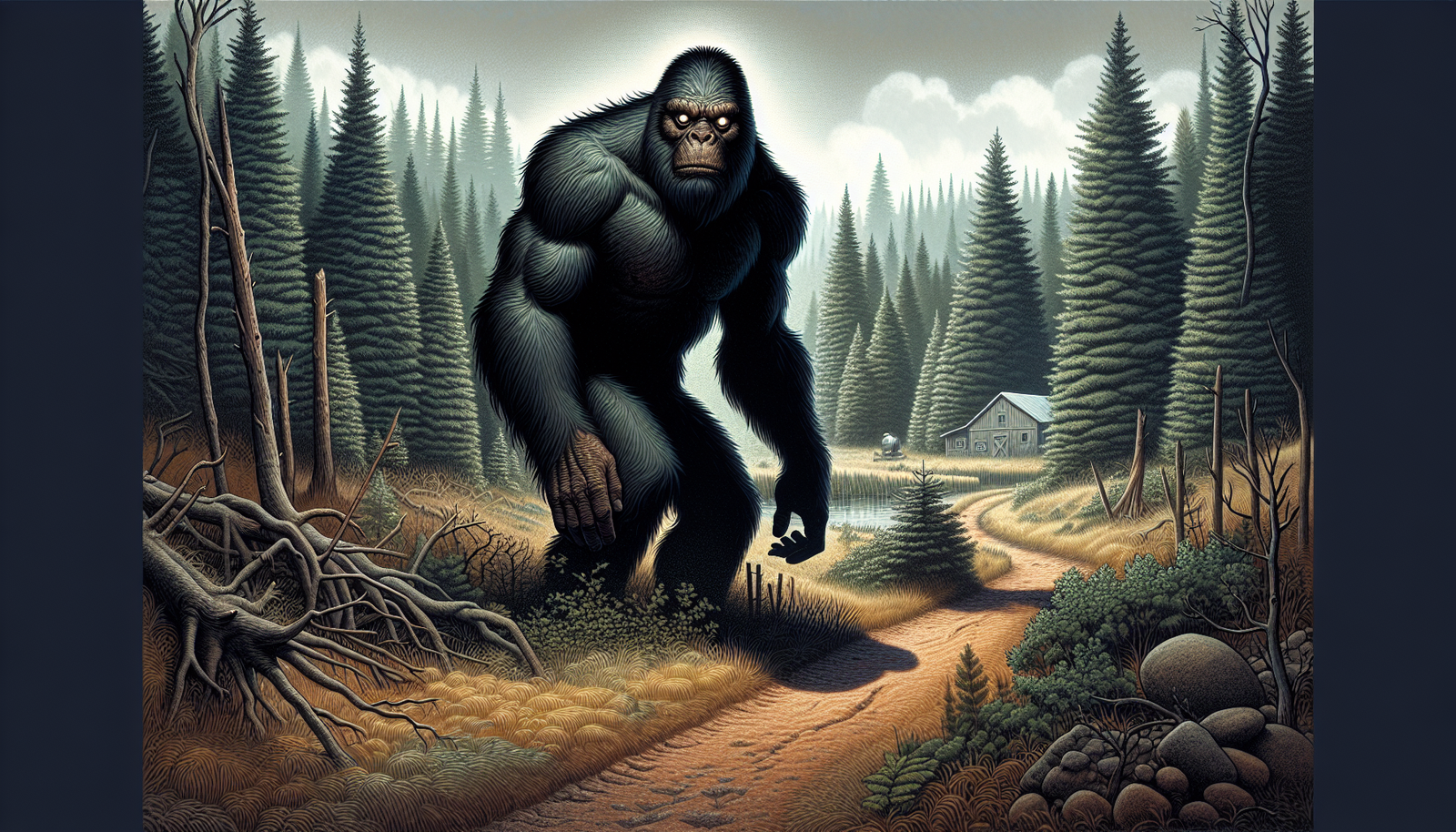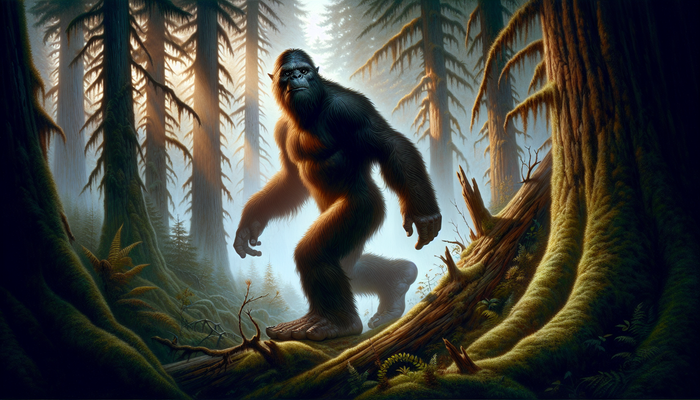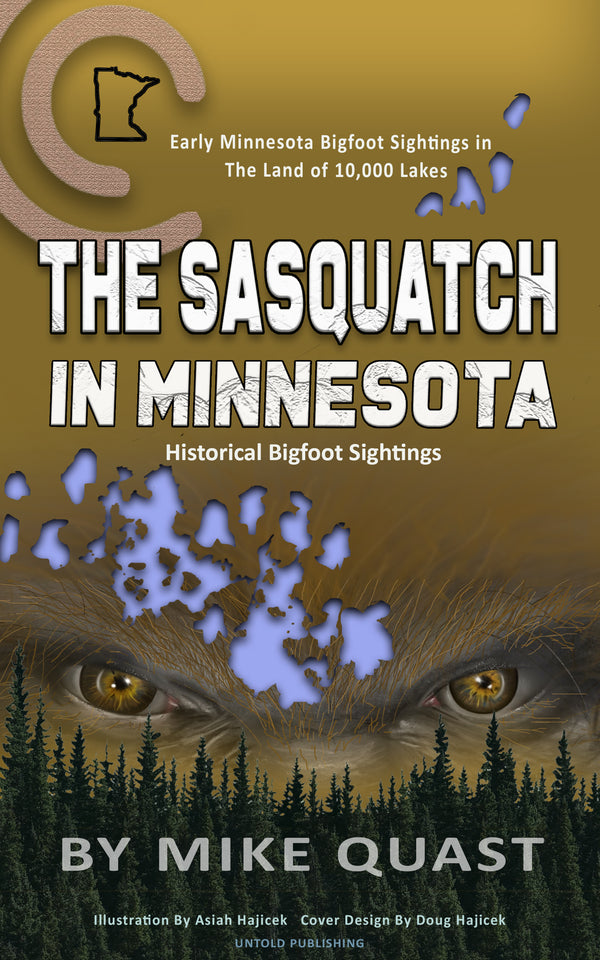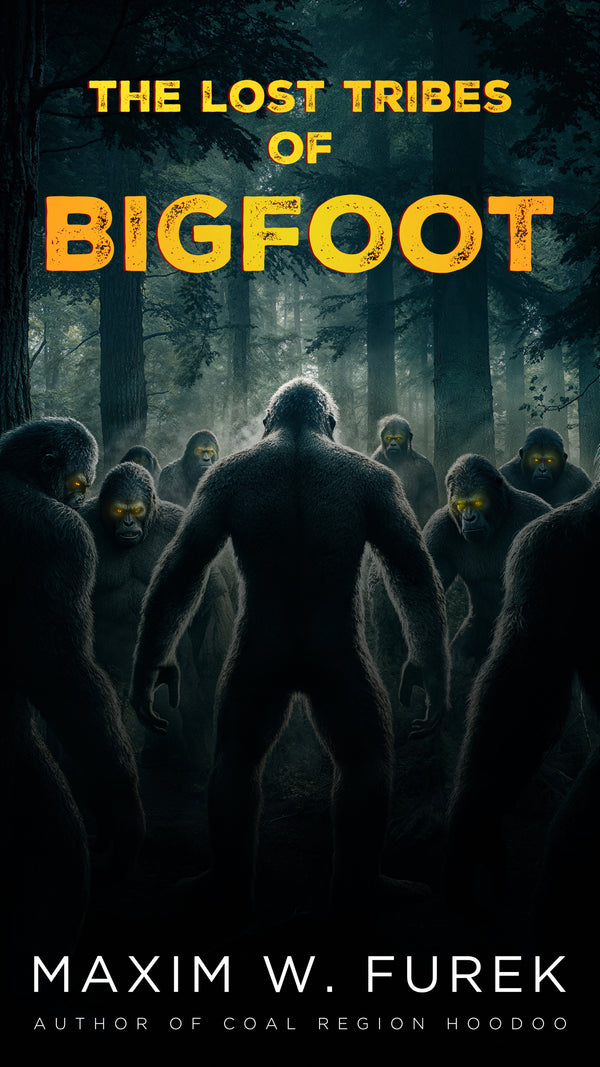Wisconsin's Bigfoot Hotspots and Sightings

By Jack Sullivan, Cryptozoologist
In the realm of cryptozoology, few creatures have captured the imagination quite like Bigfoot. This elusive, ape-like being has been the subject of countless stories, investigations, and debates, with sightings reported across North America and beyond. But while many associate Bigfoot with the dense forests of the Pacific Northwest, a surprising contender has emerged as a hotspot for encounters: the state of Wisconsin.
With over 100 documented sightings since the 1970s, Wisconsin has solidified its reputation as the Bigfoot capital of the Midwest. From the ancient forests of the Northwoods to the winding rivers and sprawling wetlands, the Badger State seems to offer the perfect habitat for this mysterious creature. As a dedicated Bigfoot researcher, I've spent years delving into the fascinating history of Wisconsin's Bigfoot encounters, and what I've uncovered has only deepened the mystery surrounding this legendary being.
Wisconsin: The Bigfoot Capital of the Midwest
To understand why Wisconsin has become such a focal point for Bigfoot activity, one need only look at the state's unique geography and ecology. The majority of sightings have been concentrated in the northern and central regions, where vast expanses of rugged, undeveloped land provide ample cover and resources for a creature of Bigfoot's supposed size and habits.
The Northwoods, in particular, seem tailor-made for a Bigfoot population. These ancient forests, dominated by towering pines, hemlocks, and hardwoods, offer a dense canopy and ample vegetation for concealment. The region's numerous rivers, lakes, and wetlands provide easy access to water and a variety of potential food sources, from fish and small mammals to berries and other vegetation.
But it's not just the landscape that makes Wisconsin an ideal Bigfoot habitat. The state's relatively low human population density, especially in the more remote areas, means fewer chances for encounters and disturbances. This, combined with the abundance of deer and other prey species, could allow a creature like Bigfoot to thrive undetected for generations.
Of course, the question remains: why would an undiscovered primate choose Wisconsin, of all places, to call home? Some researchers speculate that the state's harsh winters and ample snowfall may actually work in Bigfoot's favor, providing a unique adaptation that sets it apart from known ape species. Others point to the dense understory and ample water sources as key factors, suggesting that Wisconsin's specific mix of habitat features may be particularly attractive to this elusive being.
Marinette County: Wisconsin's Premier Bigfoot Hotspot
Within Wisconsin, one county stands out as a true epicenter of Bigfoot activity: Marinette County. Located in the northeastern corner of the state, this heavily forested, sparsely populated region has been the site of at least nine reported Bigfoot encounters since the 1970s, making it a prime destination for researchers and enthusiasts alike.
One of the most compelling Marinette County sightings occurred in July 2018, when a retired police officer spotted a large, hairy, bipedal creature crossing a highway near the town of Pembine. The witness, who had decades of experience in law enforcement, described the creature as standing around 7-8 feet tall, with a pointed head, broad shoulders, and large biceps. He noted that the creature moved with remarkable speed and agility, crossing the road in just a matter of seconds before disappearing into the surrounding woods.
This sighting is just one of many that have emerged from Marinette County over the years. Other notable encounters have been reported near the city of Crivitz, where witnesses have described seeing Bigfoot-like creatures lurking in the dense hardwood forests and expansive wetlands that characterize the area.
The sheer volume and consistency of sightings in Marinette County have even inspired an annual gathering known as the Marinette-Menominee Bigfoot Convention. This event, which draws researchers, witnesses, and enthusiasts from across the country, provides a platform for sharing experiences, presenting new evidence, and discussing the latest developments in the field of Bigfoot research.
Other Wisconsin Bigfoot Hotspots
While Marinette County may be the most famous Bigfoot hotspot in Wisconsin, it's far from the only one. Neighboring counties like Price, Vilas, Oconto, and Oneida have collectively been the site of over 22 reported sightings, each adding to the growing body of evidence that suggests a Bigfoot presence in the Northwoods.
One of the most intriguing encounters in recent years occurred in October 2021, when a duck hunter in Vilas County spotted a large, bipedal figure moving quickly through a marsh near the Powell Marsh Wildlife Area. The witness, who was familiar with the local wildlife, insisted that the creature was not a bear or any other known animal, describing it as having a hunched posture and moving with surprising speed and agility.
Another notable sighting comes from Price County, where a BFRO investigator claimed to have captured thermal footage of a Bigfoot-like creature while on a five-day expedition. Although brief, this footage represents one of the most compelling pieces of evidence to emerge from Wisconsin in recent years, and has only fueled further interest in the state's Bigfoot phenomenon.
For researchers and enthusiasts looking to conduct their own investigations, these counties offer a wealth of opportunities. From the abundant campgrounds, cabins, and resorts that can serve as basecamps, to the extensive trail systems and remote waterways that crisscross the region, there's no shortage of prime Bigfoot habitat to explore. Whether it's setting up trail cameras, conducting night vigils, or simply hiking through the backcountry with a keen eye and an open mind, these hotspots provide ample chances to potentially glimpse this elusive creature.
Famous Wisconsin Bigfoot Encounters
Wisconsin's Bigfoot legacy is built upon a foundation of compelling eyewitness accounts, each adding another layer to the mystery surrounding this cryptid. Some of these encounters have become the stuff of legend, inspiring books, documentaries, and even feature films.
One of the earliest and most famous Wisconsin Bigfoot sightings occurred in 1976, near the small town of Cashton in Monroe County. A local farmer, who had previously dismissed Bigfoot as a mere legend, was shocked when he encountered a massive, hairy, bipedal creature while out herding his cows one morning. The farmer described the creature as standing around 7-8 feet tall, with a broad, muscular build and an overwhelming, foul odor.
The encounter left the farmer and his family deeply shaken, and they reportedly spent weeks in a state of near-constant fear, worried that the creature might return. The story quickly spread throughout the community, sparking a media frenzy and cementing the "Cashton Creature" as one of Wisconsin's most enduring Bigfoot legends.
Another famous Wisconsin Bigfoot is the so-called "Cumberland Beast," which has been spotted numerous times over the decades in and around the city of Cumberland in Barron County. Witnesses have consistently described a large, hairy, bipedal creature with a wolf-like head, often spotted lurking in cornfields, peering into windows, or crossing roads in the dead of night.
One of the most unnerving Cumberland Beast encounters occurred in the mid-1990s, when two young sisters spotted the creature while playing in a cornfield near their family's property. The girls, who were just 11 and 12 years old at the time, described the beast as standing around 7 feet tall and being covered in dark, matted hair. They noted that the creature seemed just as startled as they were, quickly turning and fleeing back into the woods when it realized it had been spotted.
But perhaps no Wisconsin Bigfoot has captured the public imagination quite like the "Bray Road Beast" of Walworth County. This creature first gained notoriety in the 1990s, thanks in large part to the investigative work of journalist Linda Godfrey. Godfrey uncovered a series of sightings centered around the rural thoroughfare of Bray Road, with witnesses describing a large, upright, wolf-like creature with glowing eyes and a menacing presence.
One particularly chilling Bray Road Beast encounter involved a woman who claimed to have seen the creature lurking outside her home late one night. She described it as being around 7 feet tall, covered in dark fur, and possessing an intense, almost malevolent gaze. The sighting left the witness deeply traumatized, and she reportedly struggled for years to come to terms with what she had seen.
The Bray Road Beast has since become a cultural phenomenon, inspiring numerous books, documentaries, and even a feature film. Its enduring legacy has helped to cement Wisconsin's reputation as a hotbed of Bigfoot activity, and has inspired countless researchers and enthusiasts to visit the area in hopes of catching a glimpse of this legendary creature.
Wisconsin's Other Cryptid: The Hodag of Rhinelander
While Bigfoot may be Wisconsin's most famous cryptid, it's far from the only legendary creature said to roam the state's forests and waterways. In the Northwoods city of Rhinelander, locals have long told tales of the Hodag, a fearsome, reptilian beast with a row of sharp spines running down its back.
The Hodag legend can be traced back to the late 1800s, when a local prankster named Eugene Shepard claimed to have captured the creature alive. Shepard's "Hodag" was actually an elaborate hoax, a monstrous taxidermy creation cobbled together from various animal parts and papier-mâché. But despite being exposed as a fraud, the Hodag quickly took on a life of its own, becoming a beloved part of Rhinelander's local folklore.
Over the years, numerous witnesses have come forward with their own Hodag encounter stories. One of the most famous occurred in the 1930s, when a group of loggers claimed to have been terrorized by the creature while working in the woods outside of town. The loggers described the Hodag as being around 7 feet tall, with a long, serpentine neck, glowing red eyes, and a mouthful of razor-sharp teeth.
While the Hodag may not have the same level of mainstream recognition as Bigfoot, it remains an important part of Wisconsin's cryptozoological landscape. In Rhinelander, the creature is celebrated with an annual festival, complete with Hodag-themed parades, contests, and merchandise. Its likeness can be found throughout the city, from statues and murals to the mascot of the local high school sports teams.
For cryptid enthusiasts, the Hodag serves as a reminder that Wisconsin's wilderness is home to all manner of strange and mysterious creatures, each with its own unique history and folklore. Whether one believes in the literal existence of these beings or simply appreciates them as cultural touchstones, there's no denying the enduring power and appeal of Wisconsin's legendary monsters.
The Hyden Adventure: A Bigfoot Encounter Turned Tourist Attraction
In 2012, a couple from Menominee, Michigan, had a Bigfoot encounter that would change their lives forever. Craig and Barb Sulk were reviewing footage from one of the many trail cameras set up on their 80-acre property when they spotted a strange, bipedal figure in the distance. Intrigued, they reached out to the Bigfoot Field Researchers Organization (BFRO), who analyzed the footage and deemed it a potentially credible Bigfoot sighting.
For the Sulks, this was the beginning of a journey that would transform their property into a one-of-a-kind Bigfoot research and tourism destination. They christened their land "The Hyden Adventure," a play on the elusive nature of the Bigfoot creature, and began inviting researchers, enthusiasts, and curious visitors to come and explore the site for themselves.
At The Hyden Adventure, guests can tour the exact spot where the Sulks' trail camera captured the mysterious figure, as well as hike the surrounding woods in search of additional evidence. The Sulks also offer guided expeditions, educational presentations, and even overnight camping experiences, allowing visitors to fully immerse themselves in the world of Bigfoot research.
Over the years, The Hyden Adventure has become a pilgrimage site of sorts for the Bigfoot community. Researchers from across the country have visited the property to conduct their own investigations, share their findings, and compare notes with fellow enthusiasts. The Sulks have hosted numerous events and conferences, including the annual Marinette-Menominee Bigfoot Convention, which has drawn speakers and attendees from as far away as California and Florida.
But perhaps the most important role The Hyden Adventure has played is in providing a safe, welcoming space for Bigfoot witnesses to share their stories. Many of the visitors to the property have had their own encounters with the creature, but have been hesitant to speak out for fear of ridicule or disbelief. At The Hyden Adventure, they find a community of like-minded individuals who understand and appreciate their experiences, and who are committed to approaching the Bigfoot phenomenon with an open and inquisitive mind.
Tragically, Craig Sulk passed away in 2021 after a battle with cancer. But his legacy lives on through The Hyden Adventure, which Barb has vowed to keep running in his memory. For the Bigfoot community, the property remains a vital resource and a testament to the enduring power of the Bigfoot legend. And for the Sulks, it stands as a tribute to the wonder and mystery that first drew them into the world of Bigfoot research, and the countless lives they've touched along the way.
The Bigfoot Field Researchers Organization (BFRO) in Wisconsin
No discussion of Wisconsin's Bigfoot phenomenon would be complete without mentioning the Bigfoot Field Researchers Organization (BFRO), the leading scientific research group dedicated to the study and investigation of the Bigfoot creature. Founded in 1995, the BFRO has been at the forefront of Bigfoot research for over two decades, and has played a crucial role in documenting and analyzing sightings across North America.
In Wisconsin, the BFRO has been particularly active, investigating numerous high-profile sightings and conducting regular expeditions in the state's Bigfoot hotspots. The organization maintains a comprehensive database of Wisconsin Bigfoot encounters, which includes detailed witness accounts, geographic data, and even physical evidence like footprint casts and hair samples.
One of the BFRO's most notable Wisconsin investigations occurred in the early 2000s, when a series of sightings were reported in the Chequamegon-Nicolet National Forest in the northern part of the state. BFRO researchers spent weeks in the area, interviewing witnesses, scouring the woods for evidence, and even conducting nighttime stakeouts in hopes of catching a glimpse of the creature.
While no definitive proof of Bigfoot's existence was found during this particular investigation, the BFRO's efforts helped to bring renewed attention to Wisconsin's Bigfoot phenomenon, and inspired a new generation of researchers and enthusiasts to get involved in the search.
From Bigfoot to UFOs: Hangar 1 Publishing Has You Covered!
Explore Untold Stories: Venture into the world of UFOs, cryptids, Bigfoot, and beyond. Every story is a journey into the extraordinary.
Immersive Book Technology: Experience real videos, sights, and sounds within our books. Its not just reading; its an adventure.



























